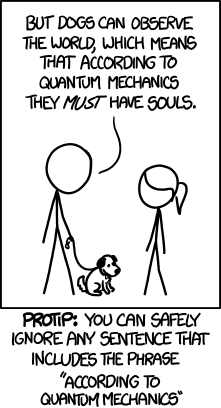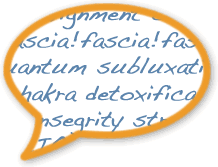
Therapy Babble
Hyperbolic, messy, pseudoscientific ideas about manual therapy for pain and injury rehab are all too common
Therapy babble is an irritating combination of jargon, bafflegab, pseudoscience, and abused science that sounds impressive but means little, which can persuade the unwary.1 It’s particularly common in alternative health care and especially the manual (hands-on) therapies, and my own former profession of massage therapy is especially rotten with it (see this collection of dozens of bizarre examples). But no profession is immune — some physical therapists and a few physicians indulge in it too. Consumers and professionals alike need to learn to spot it and shun the perpetrators. This article pokes fun at them.
A brief serious note, though: There is no place for amateurism in health care. People in pain need real help, and they deserve better than half-baked theories based on fringe science and fads.

This is not a statue of a “facepalm”: it’s a depiction of “Cain After Killing His Brother Abel,” by Henri Vidal, found in the Tuileries Garden in Paris. In this framing, however, it is perfectly suited to the more modern intepretation!
How therapy babble works
Therapy babble often starts with a folksy preamble that clarifies or confirms something fairly obvious in a charming way — “So the spine is like a stack of bricks, see?” This tactic builds credibility and engages the audience before moving decisively into wild speculation and vague science-y excitement passed off as a serious professional opinion.
A little legitimate terminology may be as close as some therapy babble gets to real science. The therapy babbler loves nothing better than a theory that sounds plausible and emotionally appealing, but can’t or likely won’t be tested experimentally, ever … because it’s actually quite outlandish, and serious researchers just can’t work up any interest.
The therapy babbler is above all full of big talk about things that just cannot be known or applied with any confidence, such as absurdly complex dot-connecting theories, or theories about causes of “all pain.” This is a general failing of alternative health care: assigning great significance to things that are really subtle, strange, and/or complex, to the point of absurdity.
“Sixty-one.”
— Dr. Harriet Hall, estimating the number of “one true causes of all diseases” promoted by quacks
For instance, many a therapy babbler has babbled about craniosacral therapy, a gentle skull handling technique popular particular among massage therapists, with a rationale that sounds a lot more scientific than it is. This treatment requires us to believe that therapists are not only able to “manipulate the cerebrospinal fluid circulatory rhythm” (quite a dubious claim in itself) — but to do so with such mastery and precision that they can reliably produce a therapeutic effect (a much taller order).
Is anyone that smart? No — no one is actually capable of producing significant medical benefits merely by lightly touching your head. Anyone who claims that they can do so has an inflated self-esteem7 (and probably worse).
Deepities
A trickier and common flavour of therapy babble is the “deepity.” Seattle Rolfer Todd Hargrove has written well about some of the “deepities” of therapy: vague ideas that shift their meaning, dodging from profound-but-false to true-but-trivial, like the “power of intention” or “energy work.”8
Science crankery
Science cranks are a significant sub-species of therapy babbler. They have a lot of admirably sincere enthusiasm about science, which sets them apart from most other therapy babblers, who are merely paying lip service to science. The crank is truly keen on science, but just isn’t any good at it — downright terrible, actually.
Just like conspiracy theorists seem a bit brain-glitchy, like they might have a mild form of mental illness,9 so too science cranks exhibit some suspiciously consistent types of reasoning problems, which might be more about malfunctions than mere mistakes. They suffer from crippling confusion about the relevance and weight of ideas. To them, whatever they aim their attention at is significant, nothing that seems similar is a coincidence, and the scientific method is basically just identifying superficial connections and blowing them way out of proportion. Speculation is always good enough.
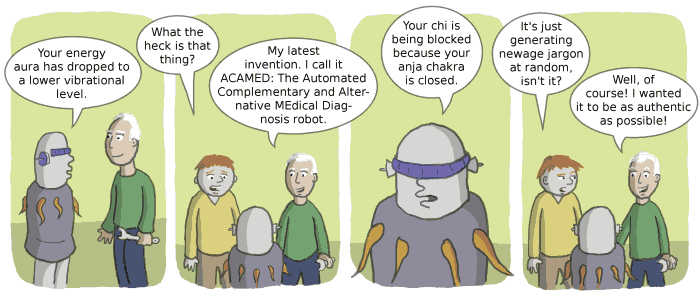
You can’t make this stuff up! The McLachlan butt reflexology hoax
Or maybe you can. Fake therapy babble is about as good as the real thing! And I have proof.
For instance, in 2010, organizers of an alternative medicine conference accepted a prank submission from Dr. John C. McLachlan10 in the spirit of the famous Sokal hoax.11 He invented a new therapy theory to justify butt reflexology and acupuncture, based on a butt homunculus. He claimed to have done studies showing that “responses are stronger and of more therapeutic value than those of auricular or conventional reflexology.”
“Arsology!” quipped Dr. David Colquhoun. PZ Myers suggested “therapeutic ass-cupping.”
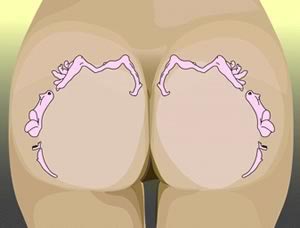
McLachlan’s butt humunculus
This is made up — fake therapy babble. But an alternative medicine conference swallowed it hook, line & sinker.
Poe’s law says that it’s difficult to tell the difference between sincere extremism and an exaggerated parody of it. Indeed, deliberately nonsensical therapy babble easily fools other therapy babblers. There doesn’t seem to be anything too ridiculous for alternative medicine. Even the rankest nonsense is accepted at face value by many, because they are eager to believe.
So called integrative medicine should not be used as a way of smuggling alternative practices into rational medicine by way of lowered standards of critical thinking. Failure to detect an obvious hoax is not an encouraging sign.
Dr. John C. McLachlan, “Integrative medicine and the point of credulity”
Do you have a license for that nonsense?
Ironically, although therapy babble always tries to seem scientific, the therapy babbler is highly prone to babbling for the sheer joy of talking trash about science and so-called “mainstream” or “allopathic”12 medicine … with the side benefit of trying to look impressive by comparison13 — “my crank science is better than your mainstream science.” One of the all-time best examples I have ever seen of this is this cranky attack on science in Massage Magazine in August, 2009.
And yet therapy babblers are science dilettantes: they do not have the education, skills, or work experience required for serious thinking about what works and why. Many hold beliefs that are blatantly at odds with even basic scientific literacy. For instance, even with much more extensive training than most massage therapists, a great many of my former colleagues still talk seriously about energy work.14
“I could eat a can of alphabet spaghetti and shit out a more comprehensive argument than Deepak Chopra.”
unknown skeptic
In health care, no one is immune to babbling, but some professions are more prone to it than others, and you can guess which ones. Doctors are the most likely to avoid it. Medical training is more substantial than it is for any other profession, despite propaganda to the contrary from some professions.15 Even physicians are notoriously ignorant of how science actually works,1617 many are surprisingly uncomfortable with evidence-based medicine, and they particularly lack knowledge of musculoskeletal health care.18 But, on average, they do have much more education, and much greater exposure to diverse clinical problems, and therefore tend to produce a lot less therapy babble than many other professions — mostly because they know better than to try! They mostly stick to guidelines and best practices.
Some doctors are scientists—just as some politicians are scientists—but most are not. … Most doctors follow familiar patterns and rules, often improvising around those rules. In their methods of working they are more like jazz musicians than scientists.
Doctors are not scientists, Smith (British Medical Journal)
Many non-doctors, on the other hand, often don’t even realize how much they don’t know, and they are treading on thin ice when they overconfidently promote (or even trademark) amateurish pet theories about pathology, etiology, and treatment mechanisms. There are always exceptions, of course, but most professionals are just not qualified for it, and there’s little need for pioneering clinicians to try to blaze new trails.19 It’s too late in medical history for that. Instead, almost all professionals should be reviewing heeding clinical guidelines and reviewing basic physiology and anatomy, not trying to revolutionize therapy or cook up rationalizations for untested methods. They should be saying “I don’t know” and “maybe” more often than anything else by an order of magnitude.
Theorizing can be fun and interesting, and it’s a part of most good clinical reasoning — but only when leavened with lots of humility.
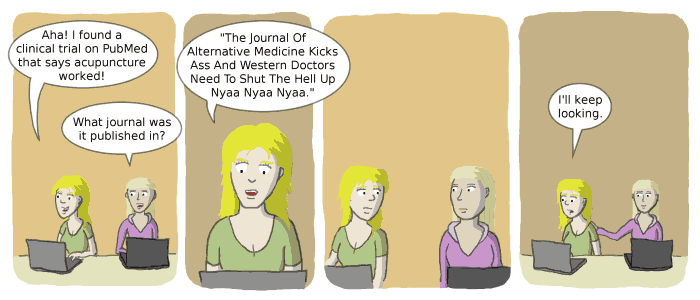
When therapy babble verges on making sense
A lot of babble is easy to spot … and dismiss. Like this, for instance:
It is entirely possible to harness healing pranic energy and improve mental health by keeping the psoas [muscle] healthy.
“The ‘Muscle of the Soul’ may be Triggering Your Fear and Anxiety,” Waking Times
Spiritual and mental health benefits? From making a specific muscle healthier? This is too silly for most people to take seriously, like butt reflexology. Psoas worship is absurd even without something like this.
But there’s a large grey zone of pseudo-babble that is more problematic because it’s harder to identify. The bane of my professional existence are the therapy theories that are just reasonable enough that it would be impolite to laugh, but too vague and slippery to efficiently torpedo them.
Consider this fine gem of a real example, recently obtained from a discussion on Facebook (an excellent source for this). What it means and whether it is correct or not is beside the point. What matters is the style of thinking: superficially plausible and science-y, a fragile chain of reasoning and assumptions. Behold the pretension to precision about so many largely unknowable things:
The infraspinatis [sic] is often overstretched by pec minor, pec major, abs, and if the person is right handed, usually the R QL [right quadratus lumborum] and R Erector spinae ....but instead of using myfacial [sic] release or trigger points on infraspinatus (which would effectively lengthen or stretch an already overstretched muscle) and fighting under the scapula to give it 'some love' which will unstabilize [sic] the joint even more, I would recommend addressing the contracted muscles prior to shortening the infraspinatus so that it can contract back to a regular length without adding pressure to the glenohumeral joint or shifting the acromialclavicular [sic] joint.
Hmm, really? Can anyone actually know that it all works like that? Is the pectoralis minor really an antagonist to the “infraspinatis”?20 More to the point: can $100/hour therapy be justified with that kind of talk?
Aside from all the egregious spelling failures with key terminology — never a confidence builder! — the problem here is not exactly that it’s obviously silly or wrong — because it’s not obvious, certainly not to the average person — but that it is so outrageously overconfident, so completely opposite of humble. It is a stack of sloppy assumptions, delivered with a glib certainty that is not remotely appropriate. It’s like listening to someone talk breezily about the reagents and steps required to cast a spell, just exactly as if it were all real.
See the NUCCA chiropractic example in the appendix for another particularly incredible example of this kind.
It’s not plausible to a well-educated professional who puts on a thinking cap. But it sounds impressive to the average patient, and even to most professionals. This is exactly what the mainstream of clinical reasoning in the professions of massage therapy and chiropractic sounds like, and (alas) to a great extent in physiotherapy as well. Indeed, talk like this powers a huge continuing education industry, and emanates routinely from many professional “gurus” and workshop instructors, and seems to be almost universally accepted as the way any serious therapist is actually supposed to talk.21
And if you challenge it? If you dare to poke it with a rhetorical stick? Why, it gets louder, longer, and more elaborate and confident! People pushing logic like that never back down, never show a trace of the humility that most alternative medicine practitioners decry the lack of in doctors.
Many of my readers will be outraged — as usual — by my impertinence. How dare I denigrate some of the most respected thinking in the profession?
It just comes naturally to me, I guess.
About Paul Ingraham
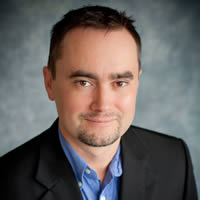
I am a science writer in Vancouver, Canada. I was a Registered Massage Therapist for a decade and the assistant editor of ScienceBasedMedicine.org for several years. I’ve had many injuries as a runner and ultimate player, and I’ve been a chronic pain patient myself since 2015. Full bio. See you on Facebook or Twitter., or subscribe:
“While I mostly agree with this article, the author seems like a real jerk! Who put sand in his lube I wonder?”
Facebook comment about this article
Related Reading
- Pain Science Reading Guide for Skeptics — A tour of PainScience.com for readers who have doubts and concerns about the validity and efficacy of popular treatments for injuries and chronic pain
- The Not-So-Humble Healer — Cocky theories about the cause of pain are waaaay too common in massage, chiropractic, and physical therapy
- 13 Kinds of Bogus Citations — Classic ways to self-servingly screw up references to science, like “the sneaky reach” or “the uncheckable” Babbler’s with academic pretensions often lace their writings with bogus citations.
- Does Fascia Matter? — A detailed critical analysis of the clinical relevance of fascia science and fascia properties. Excessive enthusiasm about fascia is a major source of therapy babble.
- 💩 Massage Therapists Say — A compilation of more than 50 examples of the bizarre nonsense spoken by massage therapists with delusions of medical knowledge
- Pseudo-Quackery in Physical Therapy — The large, dangerous grey zone between evidence-based care and overt quackery in treatment for sprain and injury
- Healer Syndrome — The problem with health care professionals, especially in alternative medicine, who want to be known as “healers”
Appendix: More examples of therapy babble
Word salad! Here’s a particularly dazzling, real example of therapy babble, from a massage therapist in a Facebook discussion. Almost every word needs a [sic]. There is scarcely a single correct thing here, and some of it is truly incoherent:
I find the easiest way to treat the psoas is neurologically by using the plantar/dorsa action of the ankle. This way you also activate the proper firing order of the fibers that I have discovered. On dorsa flexion they will fire from l1 to l4 and plantar flexion 4–1. This normally puts the psoas in a good posture. Since the pectineus works to stabilize the movement created by the psoas it should help in balancing this structure also unless there is inhibitors being processes. I agree too much other stuff in the area for any direct and hard pressure work.
I smell pet theory! There’s plenty of therapy babble in junky science. Here’s a “scientific” study that compares two kinds of massage for shoulder pain: regular Swedish versus “tensegrity-based” massage.22 This phrase — “tensegrity-based” — is the babble I’m highlighting, although there’s plenty more in the actual paper. I have literally never heard of it in 15 years of studying massage (although it’s easy enough to guess what they think they mean.) That’s because “tensegrity-based” massage is not actually a thing, and doesn’t really mean anything. There is no TBM® or standard definition. It means about as much as “anatomy-based.” Tensegrity refers to a principle of biomechanical organization (see Ten Trillion Cells Walked Into a Bar). Massage “based on the tensegrity principle” is wide open to interpretation to the point of absurdity. But it certainly sounds science-y.
NUCCA nuttiness! Here’s an example that is nearly impossible for a non-expert to identify as anything except a pile of jargon. This comes from the private correspondence of a NUCCA chiropractor:
With the manifestation being a possible connection between the heart and the bite and the symptoms showing as spinothalamic tract sequelae I can’t help but consider the connection between the nucleus ambiguous (motor nucleus of vagus that innervates bite mm’s and the heart), the nucleus tractus solitaries (sensory nucleus of vagus therefore heart and bite mm’s etc) and their connection to the heart and branchial musculature might be at play.
The relationship between occlusional imbalances and expressions of irritation to the organ systems as well as spinal trigeminal sensory nucleus (the cranial extension of the spinothalamic tract) makes these neurophysiological connections very plausibly causal in M’s current heath challenge. These connections combined with the temporal association of the teeth reacting post root canal makes me concerned that there is the TMD issue or a tooth infection at work here hyper-sensitizing M to her CCJ misalignment and creating this episodic dysautonomia.
I’ll add more examples over time, of course. Got any of your own? Please send ‘em to me!
What’s new in this article?
2018 — Added an xkcd comic, plus some other minor improvements.
2018 — Added a small new section about “science crankery.”
2009 — Publication.
Notes
- Weisberg DS, Keil FC, Goodstein J, Rawson E, Gray JR. The seductive allure of neuroscience explanations. Journal of Cognitive Neuroscience. 2008 Mar;20(3):470–7. PubMed 18004955 ❐ PainSci Bibliography 53859 ❐
This study found that ordinary people were more satisfied with bogus neuroscience talk than experts were. In other words, less educated folks are somewhat more likely to swallow fancy-sounding bullshit.
- Fascia is just a (connective) tissue. Like everything else in biology, there is some genuinely interesting science about it. However, it has become the darling of the manual therapy world to an absurd degree, and much therapy babble has been devoted to trying to explain why it matters. I have yet to see any compelling reason to think that the biology of fascia has anything to do with the laying on of hands. I’ve written a few articles about this. For instance, much has been made of the finding that fascia has a slight ability to contract. Um, so? See: Does Fascia Matter?
- There are entire commercial empires of therapy built on exaggeration of the importance of these concepts. Of course the words “alignment” and “balance” have their legitimate uses, but in the world of manual therapy they are routinely used to justify expensive and questionable therapeutic wild goose chases. Nowhere does therapy babble get so crazed as it does in the elaborate dot-connecting theories of classic structuralism.
- As many controversial therapies have failed to demonstrate that they are better than a placebo, believers have tried to spin the results as a good thing, exaggerating the “power” of placebo, talking about placebo as though it is a near-mystical phenomenon that explains why their cash-cow therapy “works.” But “placebo effects are mostly just as much an illusion as precognition or talking with the dead” (Novella). Placebo is not so powerful, not so ethical, and above all not an adequate justification for otherwise ineffective treatments. See Placebo Power Hype.
- “Tensegrity” refers to an interesting structural principle in biology. It’s a real thing, but it is often discussed as though it has vastly more significance to manual therapy than it does — which isn’t hard, because it really doesn’t have any. See Ten Trillion Cells Walked Into a Bar for some context about how tensegrity is just interesting biology (when kept in perspective), but gets blown way out of proportion by cranks and flakes.
- This one’s certainly debatable, and I think the term/idea can be used in a responsible way, but there’s certainly plenty of legitimate controversy. Some people have argued that trigger points are the quintessential therapy babble.
- See Does Craniosacral Therapy Work? Craniosacral therapists make big promises, but their methods have failed to pass every fair scientific test of efficacy or plausibility.
- If the deeper, grander meaning of either of these was taken at face value, it would be like saying that The Force from Star Wars is a real thing — which is probably going just a wee bit too far. On the other hand, there is a sense in which both are obviously true — but a rather boring sense, which probably wasn’t worth mentioning in the first place. Nevertheless, the therapy babbler will cheerfully shift the emphasis to make a deepity sound either profound or obvious, whatever suits the situation: profound as a rationale for expensive therapy or just when trying to sound like Deepak, or obvious when trying to sound humble or when challenged by a critic.
- Because they probably do: they likely have dysfunctionally hyperactive pattern-recognition, a normal and necessary mental function dialed up to eleven.
- McLachlan JC. Integrative medicine and the point of credulity. BMJ. 2010 Dec 20;341:c6979. PubMed 21147748 ❐
- Sokal hoaxes. Wikipedia.com. A hoax intended to dupe a journal into publishing something ridiculous, to expose bias and incompetence. It’s named after the infamous initial example, perpetrated by Alan Sokal, a physics professor at New York University who submitted a silly article to a presitigious journal, which they published largely because it was flattering to the editors beliefs, and they had no peer review process. There have been many Sokal-ish hoaxes since, proving that it’s surprisingly easy to publish bad science. Ergo, it’s more important than ever to consider the source.
- The term “allopathy” is itself an example of therapy babble: it is mostly used to make the speaker sound more intelligent while insulting doctors, and yet it doesn’t actually mean anything. It was made up by the father of homeopathy, Samuel Hahnemann, to dramatize the contrast between homeopathy and its competition, and that is the only way it has ever been used.
- Despite the common label “alternative and complementary” medicine, a great many massage therapists and chiropractors emphasize the “alternative,” and not the “complementary.” They perceive a rivalry with scientific medicine, and are hostile about it. See Alternative Medicine’s Choice: What should alternative medicine be the alternative to? The alternative to cold and impersonal medicine? Or the alternative to science and reason?.
![]()
Massage therapists in British Columbia, Canada, are trained quite well, a 3-year program. However, the extra training seems to have virtually no impact on their belief in “flaky” things like energy therapy. The point is that really quite a lot of training & education is needed to become a good critical thinker, as well as other factors.
- Ingraham. Chiropractor, Naturopath Training Way Less Than Doctors: Medical training is much longer and better than anything naturopaths or chiropractors normally get. PainScience.com. 1375 words.
- British Medical Journal [Internet]. Smith R. Doctors are not scientists; 2015 Jun 19 [cited 15 Jun 22]. PainSci Bibliography 54244 ❐
- Even doctors who go into research still suffer from serious biases, pride and illogic, sloppy methods and hallucinatory optimism, all the usual human failings that make science an imperfect endeavour that requires peer review and other checks and balances — and so such doctors get criticized by their colleagues for it, their research gets marginalized, it gets referenced only by people who share the bias, and so on. Even within that world of science and true medical expertise, many still aren’t smart enough to play with the big boys, and never make a valuable contribution — entire careers of half-assed science leading exactly nowhere. Yikes.
- Doctors are unqualified to care properly for most common pain and injury problems, especially the stubborn ones, and this has been proven by other doctors: Stockard et al found that 82% of graduates lacked “basic competency” in this area. For more information, see The Medical Blind Spot for Aches, Pains & Injuries: Most physicians are unqualified to care for many common pain and injury problems, especially the more stubborn and tricky ones.
- Nearly all “new” ideas about how to help people are not new at all, but in fact simply re-warmed versions of very old, discredited ideas: clichés of pseudoscience that don’t sound original at all to anyone who knows the history of medical science.
- No! The infraspinatus cannot be over or under-stretched by the pectoralis minor. Or the abdominals. Or the right quadratus lumborum. Or indeed any muscle whatsoever except its actual antagonists, primarily the subscapularis, and other muscles that internally rotate the humerus. So, right out of the gate, the first statement in the chain of reasoning is totally wrong. But, like I said, that’s kind of beyond the point. It’s the style of trying to connect dots like this that’s problematic, and it would still be problematic even if the anatomical relationships were correct.
- One of the first times I ever really got frustrated with therapy babble was at a workshop, where’d I’d paid hundreds of dollars for someone to sermonize at me like this all weekend. •shudder!• But half the participants swallowed it hook line and sinker, and to be honest — even though I was irritated — I still actually tried hard to make use of the information, and I remember quite a deliberate effort to integrate “the best of” the ideas into my practice for several months afterwards. This is what I mean when I say that therapy babble can actually be semi-plausible.
- Kassolik K, Andrzejewski W, Brzozowski M, et al. Comparison of Massage Based on the Tensegrity Principle and Classic Massage in Treating Chronic Shoulder Pain. J Manipulative Physiol Ther. 2013 Jul. PubMed 23891481 ❐
